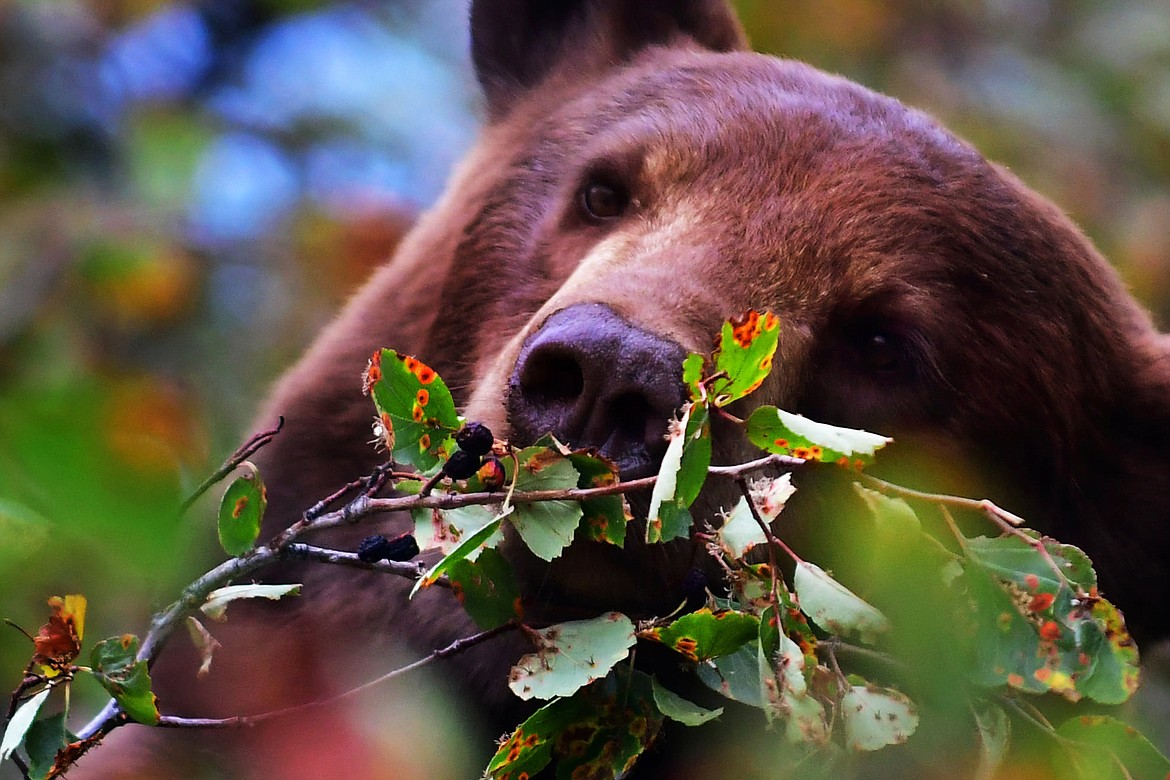Bears, conflicts, and availability of natural food sources
Bears are strongly motivated by food.
Each spring, summer and fall saddled with the challenge of creating enough fat reserves to live off through the denning season, bears are driven to exploit several caloric resources. Particularly in the fall when bears enter hyperphasia, a phase where bears metabolically have increased feeding activity to put on fat to survive in the den.
Sufficient body fat is not only needed for survival during the winter months, but female grizzly bears require a threshold of at least 20% body fat for cub production.
Given the importance diet for grizzly bears on survival and reproduction, the quality and abundance of natural foods in bear habitat is of critical importance.
When naturally occurring, calories are hard to find, bears are often driven to find anthropogenic foods leading to conflicts with people.
The availability of natural foods is a strong predictor for human-bear conflicts we have each year in the ecosystem. In 2004 study in the Greater Yellowstone Ecosystem, researchers found that incidents of bears damaging property and obtaining anthropogenic foods were inversely correlated to the availability of naturally occurring bear foods. Omnivorous bears capitalize on a variety of food sources that are seasonally and or spatially abundant within their habitats.
In the Greater Yellowstone Ecosystem, the researchers looked at the abundance of elk calves, spawning cutthroat trout, ungulate carcasses, cutworm moths, biscut roots, yampa, sweet Cecily as well as whitebark pine seeds to characterize food availability.
However, in western Montana, specifically the Northern Continental Divide Ecosystem (NCDE), natural food resources selected by bears differ. Generally, the NCDE is considered more of a berry driven ecosystem for bears looking to make a living on natural foods.
Dr. Richard Mace and Dr. Charles Jonkel conducted analysis of grizzly bear scat from the South Fork and North Fork of the Flathead River valleys. Results found fruit from 11 different shrubs and identified globe huckleberry as the most important for both areas.
In the Mission Mountains, grasses and sedges held the highest importance value, but serviceberry was found to be the dominant fruit in scats.
Different from Yellowstone, spawning cutthroat trout is not a dominant source of food for bears in the NCDE.
Selection of natural foods is very diverse across the NCDE, and researchers have found that grizzly bears are adept at capitalizing on a number of food resources that may be abundant in any given season.
Isotope research using samples of grizzly hair and blood has used ratios between types of carbon, nitrogen, and sulfur stable isotopes in hair and tissue to examine the composition of plant, animal, and marine material present in their diet. Blood gives clues to types of food consumed in the short term by bears and hair gives insight into the predominance of what a bear has eaten over the past several months.
Truly, we are what we eat. Samples of bear tissue using stable isotope work has uncovered
that grizzlies in the NCDE have a diverse diet not just in any given season, but it depends on where in the ecosystem the grizzly bears make their home.
Diets of grizzlies in the Whitefish Range, the North and South Forks of the Flathead River were, on average, composed of less than 70% mean than those of on the eastern front of the Rocky Mountains.
Is there a single indicator that services as a predictor as a high or low natural food occurrence?
Amongst bear experts west of the divide, generally the quality and abundance of the huckleberry crop is anecdotally discussed as what might drive the number of conflicts with human attractants across the ecosystem.
High in sugars and carbohydrates, huckleberries are also a major bear food and can be an
essential dietary need for bears trying to fatten up for the winter. Bears have relatively simple
digestives systems that do not process fiber from plant material efficiently making it difficult to build up fat reserves on grasses and other fibrous plants. Thus, berries play an important role in building a bear’s energy reserves.
This past year in the western part of the NCDE has been relatively quiet for grizzly bear conflict
specialists who spend their time working with property owners to resolve conflicts with bears and human attractants.
Depending on who you talk to at the grocery store, the gas pump or the bar, huckleberries were fairly easy to find this year. However, weather and spatial variability of what kinds of variables lead to a productive huckleberry crop each year are hard to pin down.
A long-range predictive tool could be useful to help managers prepare for challenging years with low natural foods and potential high chances for conflict with bears and human attractants.
In the Cabinet Mountains, researchers with the US Fish and Wildlife Service have worked to create a predictive model for understanding what kind of huckleberry crop the coming summer may bring. The work was able to correlate huckleberry production with cool springs and high July temperatures.
While this model has shown potential to forecast annual berry production, predicting the type of berry season a month or two in the future currently has limited practicality.
In any year, it is important to make sure attractants or anthropogenic foods are unavailable to
bears. However, in years where natural foods are low, it can become even more important to reduce the potential of human-grizzly bear conflicts.
Bears that have learned to find easy to access human based calories tend to return to these sources when food stressed. Hence the adage, a fed bear is a
dead bear.
Even with management intervention, bears captured and relocated after conflict tend to return to the temptation when pushed to do so over the next few years. This eventually leads to destruction of the animal referred to as a management removal. Though variable, management removals are one of the highest mortality sources for grizzly bears in the NCDE ecosystem in any given year.

